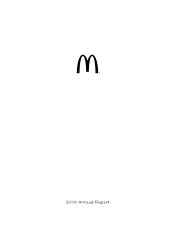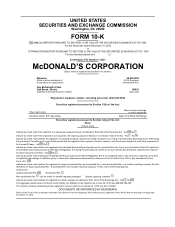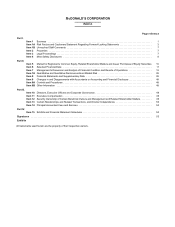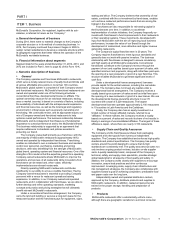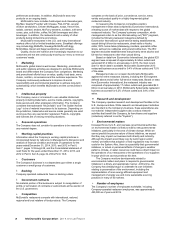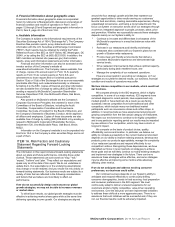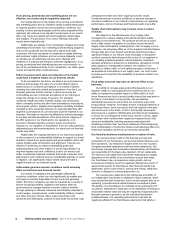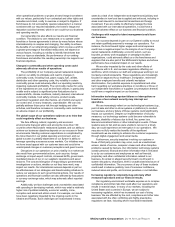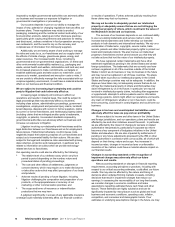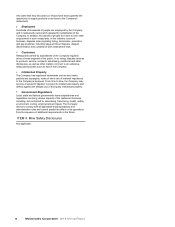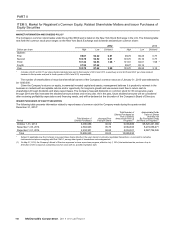McDonalds 2014 Annual Report Download - page 7
Download and view the complete annual report
Please find page 7 of the 2014 McDonalds annual report below. You can navigate through the pages in the report by either clicking on the pages listed below, or by using the keyword search tool below to find specific information within the annual report.
McDonald’s Corporation 2014 Annual Report 1
PART I
ITEM 1. Business
McDonald’s Corporation, the registrant, together with its sub-
sidiaries, is referred to herein as the “Company.”
a. General development of business
During 2014, there were no material changes to the Company’s
corporate structure or in its method of conducting business. In
2014, the Company continued the process it began in 2005 to
realign certain subsidiaries to develop a corporate structure within
its geographic segments that better reflects the operation of the
McDonald’s worldwide business.
b. Financial information about segments
Segment data for the years ended December 31, 2014, 2013, and
2012 are included in Part II, Item 8, page 42 of this Form 10-K.
c. Narrative description of business
General
The Company operates and franchises McDonald’s restaurants,
which serve a locally-relevant menu of quality food and drinks sold
at various affordable price points in more than 100 countries.
McDonald’s global system is comprised of both Company-owned
and franchised restaurants. McDonald’s franchised restaurants are
owned and operated under one of the following structures -
conventional franchise, developmental license or affiliate. The
optimal ownership structure for an individual restaurant, trading
area or market (country) is based on a variety of factors, including
the availability of individuals with the entrepreneurial experience
and financial resources, as well as the local legal and regulatory
environment in critical areas such as property ownership and
franchising. We continually review, and as appropriate adjust, our
mix of Company-owned and franchised restaurants to help
optimize overall performance. The business relationship between
McDonald’s and its independent franchisees is of fundamental
importance to overall performance and to the McDonald’s Brand.
This business relationship is supported by an agreement that
requires adherence to standards and policies essential to
protecting our brand.
The Company views itself primarily as a franchisor, with the
vast majority of McDonald’s restaurants (approximately 80%)
owned and operated by independent franchisees. Franchising
enables an individual to own a restaurant business and maintain
control over personnel, purchasing, marketing and pricing
decisions, while also benefiting from the strength of McDonald’s
global brand, operating system and financial resources. One of the
strengths of this model is that the expertise gained from operating
Company-owned restaurants allows McDonald’s to improve the
operations and success of all restaurants while innovations from
franchisees can be tested and, when viable, efficiently
implemented across relevant restaurants.
Directly operating McDonald’s restaurants contributes
significantly to our ability to act as a credible franchisor. Having
Company-owned restaurants is essential to providing Company
personnel with a venue for restaurant operations training
experience. In addition, in our Company-owned and operated
restaurants, and in collaboration with franchisees, we are able to
further develop and refine operating standards, marketing
concepts and product and pricing strategies that will ultimately
benefit relevant McDonald’s restaurants.
Under a conventional franchise arrangement, the Company
owns the land and building or secures a long-term lease for the
restaurant location and the franchisee pays for equipment, signs,
seating and décor. The Company believes that ownership of real
estate, combined with the co-investment by franchisees, enables
us to achieve restaurant performance levels that are among the
highest in the industry.
Franchisees are also responsible for reinvesting capital in
their businesses over time. In addition, to accelerate
implementation of certain initiatives, the Company frequently co-
invests with franchisees to fund improvements to their restaurants
or their operating systems. These investments, developed with
input from McDonald’s with the aim of improving local business
performance, increase the value of our Brand through the
development of modernized, more attractive and higher revenue
generating restaurants.
The Company’s typical franchise term is 20 years. The
Company requires franchisees to meet rigorous standards and
generally does not work with passive investors. The business
relationship with franchisees is designed to assure consistency
and high quality at all McDonald’s restaurants. Conventional
franchisees contribute to the Company’s revenue through the
payment of rent and royalties based upon a percent of sales, with
specified minimum rent payments, along with initial fees paid upon
the opening of a new restaurant or grant of a new franchise. This
structure enables McDonald’s to generate significant levels of
cash flow.
Under a developmental license arrangement, licensees
provide capital for the entire business, including the real estate
interest. The Company does not invest any capital under a
developmental license arrangement. The Company receives a
royalty based upon a percent of sales as well as initial fees upon
the opening of a new restaurant or grant of a new license. We use
the developmental license ownership structure in over 70
countries with a total of 5,228 restaurants. The largest
developmental licensee operates approximately 2,100 restaurants
in 19 countries in Latin America and the Caribbean.
Finally, the Company also has an equity investment in a
limited number of foreign affiliated markets, referred to as
“affiliates.” In these markets, the Company receives a royalty
based on a percent of sales and records its share of net results in
Equity in earnings of unconsolidated affiliates. The largest of these
affiliates is Japan, where there are nearly 3,100 restaurants.
Supply Chain and Quality Assurance
The Company and its franchisees purchase food, packaging,
equipment and other goods from numerous independent
suppliers. The Company has established and enforces high quality
standards and product specifications. The Company has quality
centers around the world designed to ensure that its high
standards are consistently met. The quality assurance process not
only involves ongoing product reviews, but also on-site supplier
visits. A quality leadership board, composed of the Company’s
technical, safety and supply chain specialists, provides strategic
global leadership for all aspects of food quality and safety. In
addition, the Company works closely with suppliers to encourage
innovation, assure best practices and drive continuous
improvement. Leveraging scale, supply chain infrastructure and
risk management strategies, the Company also collaborates with
suppliers toward a goal of achieving competitive, predictable food
and paper costs over the long term.
Independently owned and operated distribution centers,
approved by the Company, distribute products and supplies to
McDonald’s restaurants. In addition, restaurant personnel are
trained in the proper storage, handling and preparation of
products.
Products
McDonald’s restaurants offer a substantially uniform menu,
although there are geographic variations to suit local consumer

